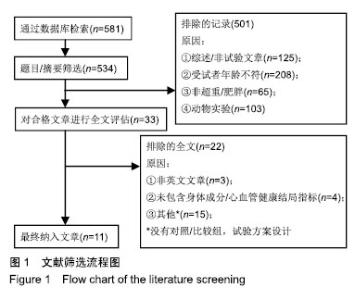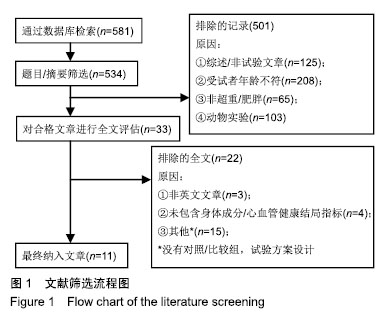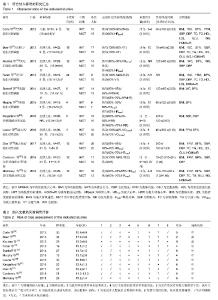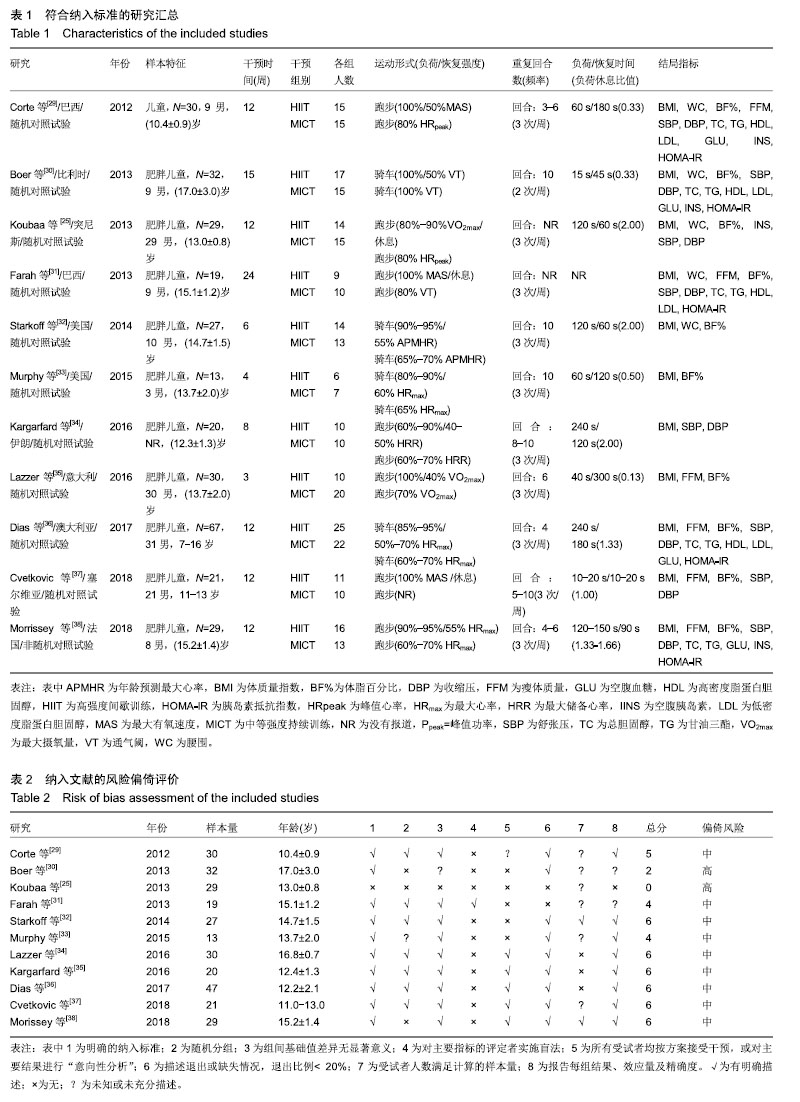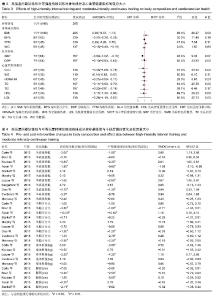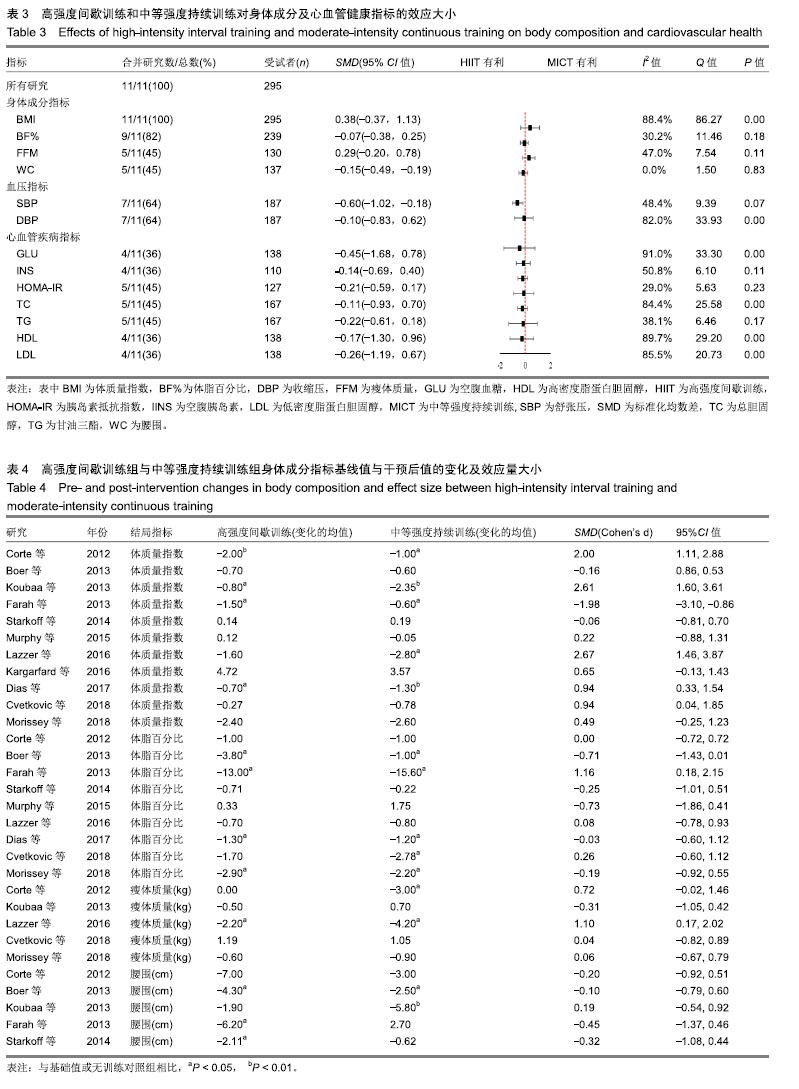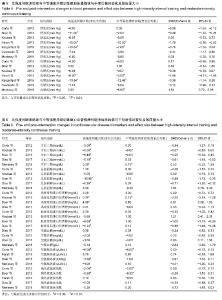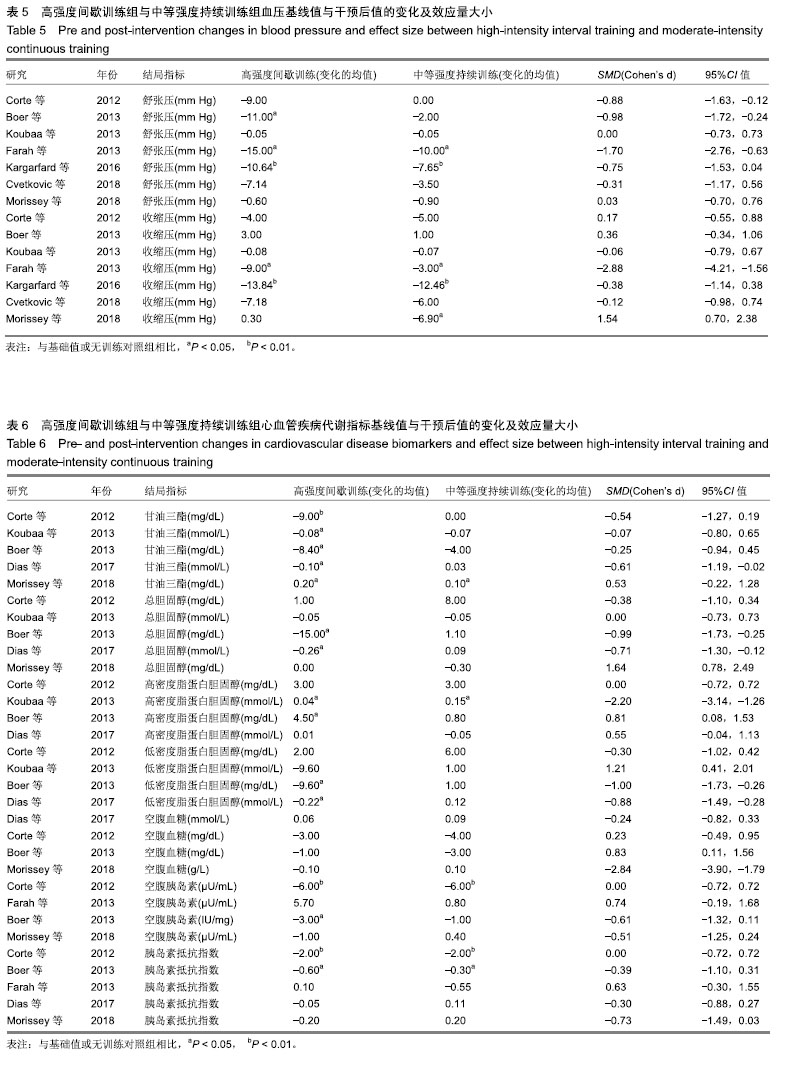Chinese Journal of Tissue Engineering Research ›› 2019, Vol. 23 ›› Issue (35): 5732-5740.doi: 10.3969/j.issn.2095-4344.1344
Similar effect of high-intensity interval training with moderate-intensity continuous training on body composition and cardiovascular health of obesity children
Cao Meng1, Quan Minghui1, Zhuang Jie2
- (1School of Physical Education and Sport Training, 2School of Sports Science, Shanghai University of Sport, Shanghai 200438, China)
-
Received:2019-05-16Online:2019-12-18Published:2019-12-18 -
Contact:Zhuang Jie, PhD, Professor, Doctoral supervisor, School of Sports Science, Shanghai University of Sport, Shanghai 200438, China -
About author:Cao Meng, Doctoral candidate, School of Physical Education and Sport Training, Shanghai University of Sport, Shanghai 200438, China -
Supported by:the National Social Science Foundation of China, No. 18BTY095 (to ZJ)
CLC Number:
Cite this article
Cao Meng, Quan Minghui, Zhuang Jie. Similar effect of high-intensity interval training with moderate-intensity continuous training on body composition and cardiovascular health of obesity children[J]. Chinese Journal of Tissue Engineering Research, 2019, 23(35): 5732-5740.
share this article
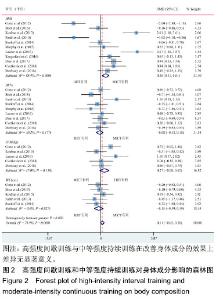
2.2 质量评价结果 纳入研究的质量评价结果见表2。纳入的研究中有9个被认为具有中等偏倚风险[29,31-38],另外2个被认为具有高偏倚风险[25,30]。 2.3 Meta分析结果 2.3.1 体质量和身体成分 纳入的11个研究,分别比较了高强度间歇训练与中等强度持续训练组在体质量指数(n=11)、体脂百分比(n=9)、瘦体质量(n=5)或腰围(n=5)上的差异。结果显示,高强度间歇训练与中等强度持续训练在改善身体成分的效果上差异无显著意义,见表3,4,图2,且高强度间歇训练与中等强度持续训练相比,反而增加了体质量指数(SMD=0.74,95%CI:0.09,1.40;P=0.03)。 "
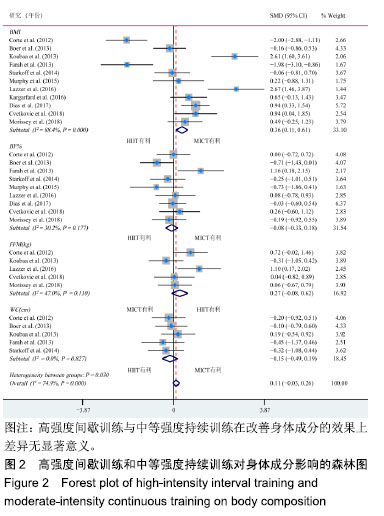
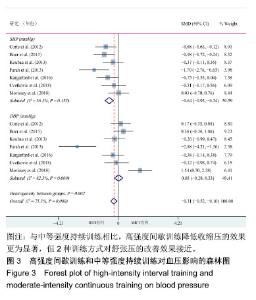
值得注意的是,尽管多数研究都未显示高强度间歇训练在体质量或身体成分上有显著改善,但高强度间歇训练组在降低体脂百分比(SMD=-0.07,95%CI:-0.38,0.25;P=0.68)和腰围(SMD=-0.15,95%CI:-0.49,0.19;P=0.38),以及增加瘦体质量(SMD=0.29,95%CI:-0.20,0.78;P=0.24)的总体趋势上比中等强度持续训练组有更大的变化,尽管这种变化不具有显著性意义,见表3。 2.3.2 血压 总共有7个研究调查了高强度间歇训练和中等强度持续训练对收缩压和舒张压的干预效果,见表3,5,图3。合并的结果显示,高强度间歇训练与中等强度持续训练相比,降低收缩压的效果更为显著(SMD=-0.60,95%CI:-1.02,-0.18;P=0.01),对舒张压的改善效果接近(SMD= -0.10,95%CI:-0.83,0.62;P=0.78),尽管有研究认为高强度间歇训练降血压的效果均比中等强度持续训练要好[31],但也有研究结论与之相反,认为中等强度持续训练使舒张压的下降幅度更大[38]。由于受试者的发育程度和性别差异等数据不充分,因而无法进一步寻找差异的来源。"
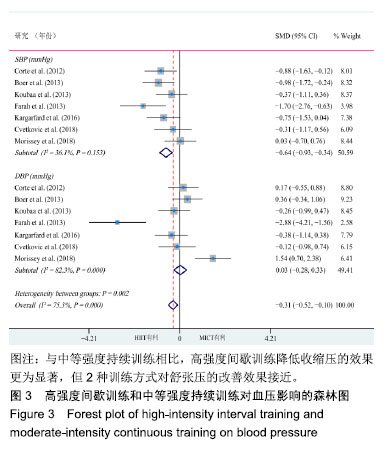
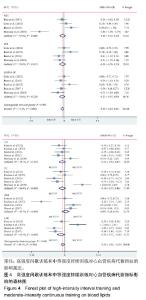
2.3.3 心血管疾病指标 5个研究包含了心血管疾病指标,分别为血糖(n=4)、胰岛素(n=4)、胰岛素抵抗指数(n=5)、总胆固醇(n=5)、甘油三酯(n=5)、高密度脂蛋白胆固醇(n=4)和低密度脂蛋白胆固醇(n=4)。从表6中可以看到,高强度间歇训练是改善心血管疾病指标的有效手段,与基础值或无训练对照组相比,高强度间歇训练能够显著降低甘油三酯[25,29-30,36,38],胰岛素[29-30],并提高高密度脂蛋白胆固醇水平[25,30],但对于降低总胆固醇和血糖则没有明显的效果。尽管一些研究结果表明高强度间歇训练对于改善心血管疾病指标的效果优于中等强度持续训练[25,30,36],但拟合后的整体效应则显示,这种差异不具有显著性,见表3,图4。 "
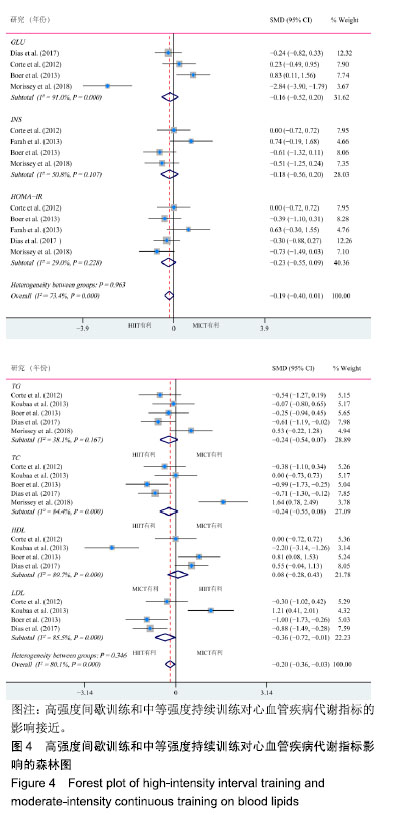
| [1]Kopelman PG. Obesity as a medical problem. Nature. 2000;404(6778): 635-643.[2]Zuckerman KE, Hill AP, Guion K, et al. Overweight and obesity: prevalence and correlates in a large clinical sample of children with autism spectrum disorder. J Autism Dev Disord. 2014;44(7):1708-1719. [3]Hosseini M, Navidi I, Hesamifard B, et al. Weight, height and body mass index nomograms; early adiposity rebound in a sample of children in tehran, iran. Int J Prev Med. 2013;4(12):1414-1420.[4]张洋,何玲.中国青少年体质健康状况动态分析——基于2000-2014年四次国民体质健康监测数据[J].中国青年研究, 2016(6):4-12.[5]Cai Y, Zhu X, Wu X. Overweight, obesity, and screen-time viewing among Chinese school-aged children: National prevalence estimates from the 2016 Physical Activity and Fitness in China-The Youth Study. J Sport Health Sci. 2017;6(4):404-409. [6]Skinner AC, Perrin EM, Moss LA, et al. Cardiometabolic Risks and Severity of Obesity in Children and Young Adults. N Engl J Med. 2015; 373(14):1307-1317. [7]Freedman DS, Mei Z, Srinivasan SR, et al. Cardiovascular risk factors and excess adiposity among overweight children and adolescents: the Bogalusa Heart Study. J Pediatr. 2007;150(1): 12-17.e2.[8]唐东辉,侯玉洁,白爽,等.运动结合饮食控制通过降低RAAS系统活性改善男性肥胖青少年血管内皮功能[J].体育科学, 2017,37(9):48-54,97.[9]Fan X, Cao ZB. Physical activity among Chinese school-aged children: National prevalence estimates from the 2016 Physical Activity and Fitness in China-The Youth Study. J Sport Health Sci. 2017;6(4): 388-394. [10][García-Hermoso A, Saavedra JM, Escalante Y. Effects of exercise on resting blood pressure in obese children: a meta-analysis of randomized controlled trials. Obes Rev. 2013;14(11):919-928. [11]Escalante Y, Saavedra JM, García-Hermoso A, et al. Improvement of the lipid profile with exercise in obese children: a systematic review. Prev Med. 2012;54(5):293-301. [12]Saavedra JM, Escalante Y, Garcia-Hermoso A. Improvement of aerobic fitness in obese children: a meta-analysis. Int J Pediatr Obes. 2011;6(3-4):169-177. [13]Bailey RC, Olson J, Pepper SL, et al. The level and tempo of children's physical activities: an observational study. Med Sci Sports Exerc. 1995; 27(7):1033-1041.[14]Sloth M, Sloth D, Overgaard K, et al. Effects of sprint interval training on VO2max and aerobic exercise performance: A systematic review and meta-analysis. Scand J Med Sci Sports. 2013;23(6):e341-352.[15]黎涌明.高强度间歇训练对不同训练人群的应用效果[J].体育科学,2015, 35(8): 59-75.[16]Lee S, Spector J, Reilly S. High-intensity interval training programme for obese youth (HIP4YOUTH): A pilot feasibility study. J Sports Sci. 2017;35(18):1-5. [17]Baquet G, Gamelin FX, Aucouturier J, et al. Cardiorespiratory Responses to Continuous and Intermittent Exercises in Children. Int J Sports Med. 2017;38(10):755-762.[18]Weston KL, Azevedo LB, Bock S, et al. Effect of Novel, School-Based High-Intensity Interval Training (HIT) on Cardiometabolic Health in Adolescents: Project FFAB (Fun Fast Activity Blasts) - An Exploratory Controlled Before-And-After Trial. PLoS One. 2016 ;11(8):e0159116.[19]García-Hermoso A, Cerrillo-Urbina AJ, Herrera-Valenzuela T, et al. Is high-intensity interval training more effective on improving cardiometabolic risk and aerobic capacity than other forms of exercise in overweight and obese youth? A meta-analysis. Obes Rev. 2016;17(6):531-540. [20]Costigan SA, Eather N, Plotnikoff RC, et al. High-intensity interval training for improving health-related fitness in adolescents: a systematic review and meta-analysis. Br J Sports Med. 2015;49(19): 1253-1261. [21]Liberati A, Altman DG, Tetzlaff J, et al. The PRISMA statement for reporting systematic reviews and meta-analyses of studies that evaluate healthcare interventions: explanation and elaboration. BMJ. 2009;339:b2700.[22]Cole TJ, Bellizzi MC, Flegal KM,et al. Establishing a standard definition for child overweight and obesity worldwide: international survey. BMJ. 2000;320(7244):1240-1243.[23]Norton K, Norton L, Sadgrove D. Position statement on physical activity and exercise intensity terminology. J Sci Med Sport. 2010;13(5): 496-502. [24]Gibala MJ, Little JP, Macdonald MJ, et al. Physiological adaptations to low-volume, high-intensity interval training in health and disease. J Physiol. 2012;590(5):1077-1084. [25]Koubaa A, Trabelsi H, Masmoudi L, et al. Effect Of Intermittent And Continuous Training On Body Composition Cardiorespiratory Fitness And Lipid Profile In Obese Adolescents. IOSR J Pharm. 2013;3(2): 31-37.[26]Weston KS, Wisløff U, Coombes JS. High-intensity interval training in patients with lifestyle-induced cardiometabolic disease: a systematic review and meta-analysis. Br J Sports Med. 2014;48(16):1227-1234.[27]Baker D. Recent trends in high-intensity aerobic training for field sports. Prof Strength Cond. 2011;22(4):1-6. [28]Higgins JP, Thompson SG, Deeks JJ, et al. Measuring inconsistency in meta-analyses. BMJ. 2003;327(7414):557-560.[29]Corte de Araujo AC, Roschel H, Picanço AR, et al. Similar health benefits of endurance and high-intensity interval training in obese children. PLoS One. 2012;7(8):e42747.[30]Boer PH, Meeus M, Terblanche E, et al. The influence of sprint interval training on body composition, physical and metabolic fitness in adolescents and young adults with intellectual disability: a randomized controlled trial. Clin Rehabil. 2014;28(3):221-231. [31]Farah BQ, Ritti-Dias RM, Balagopal PB, et al. Does exercise intensity affect blood pressure and heart rate in obese adolescents? A 6-month multidisciplinary randomized intervention study. Pediatr Obes. 2014; 9(2):111-120. [32]Higgins S, Fedewa MV, Hathaway ED, et al. Sprint interval and moderate-intensity cycling training differentially affect adiposity and aerobic capacity in overweight young-adult women. Appl Physiol Nutr Metab. 2016;41(11):1177-1183. [33]Murphy A, Kist C, Gier AJ, et al. The feasibility of high-intensity interval exercise in obese adolescents. Clin Pediatr (Phila). 2015;54(1):87-90.[34]Kargarfard M, Lam ET, Shariat A, et al. Effects of endurance and high intensity training on ICAM-1 and VCAM-1 levels and arterial pressure in obese and normal weight adolescents. Phys Sportsmed. 2016; 44(3):208-216. [35]Lazzer S, Tringali G, Caccavale M, et al. Effects of high-intensity interval training on physical capacities and substrate oxidation rate in obese adolescents. J Endocrinol Invest. 2017;40(2):217-226.[36]Dias KA, Ingul CB, Tjønna AE, et al. Effect of High-Intensity Interval Training on Fitness, Fat Mass and Cardiometabolic Biomarkers in Children with Obesity: A Randomised Controlled Trial. Sports Med. 2018;48(3):733-746. [37]Cvetkovi? N, Stojanovi? E, Stojiljkovi? N, et al. Exercise training in overweight and obese children: Recreational football and high-intensity interval training provide similar benefits to physical fitness. Scand J Med Sci Sports. 2018;28 Suppl 1:18-32. [38]Morrissey C, Montero D, Raverdy C, et al. Effects of Exercise Intensity on Microvascular Function in Obese Adolescents. Int J Sports Med. 2018;39(6):450-455.[39]Thivel D, Masurier J, Baquet G, et al. High-intensity interval training in overweight and obese children and adolescents: systematic review and meta-analysis. J Sports Med Phys Fitness. 2019;59(2):310-324. [40]LaForgia J, Withers RT, Gore CJ. Effects of exercise intensity and duration on the excess post-exercise oxygen consumption. J Sports Sci. 2006;24(12):1247-1264.[41]Boutcher SH. High-intensity intermittent exercise and fat loss. J Obes. 2011;2011:868305.[42]Crampes F, Beauville M, Riviere D, et al. Effect of physical training in humans on the response of isolated fat cells to epinephrine. J Appl Physiol (1985). 1986;61(1):25-29.[43]Krustrup P, Söderlund K, Mohr M, et al. The slow component of oxygen uptake during intense, sub-maximal exercise in man is associated with additional fibre recruitment. Pflugers Arch. 2004;447(6):855-866. [44]Krustrup P, Söderlund K, Mohr M, et al. Recruitment of fibre types and quadriceps muscle portions during repeated, intense knee-extensor exercise in humans. Pflugers Arch. 2004;449(1):56-65.[45]Nishida K, Harrison DG, Navas JP, et al. Molecular cloning and characterization of the constitutive bovine aortic endothelial cell nitric oxide synthase. J Clin Invest. 1992;90(5):2092-2096.[46]Pal S, Radavelli-Bagatini S, Ho S. Potential benefits of exercise on blood pressure and vascular function. J Am Soc Hypertens. 2013;7(6): 494-506. [47]Green DJ, Maiorana A, O'Driscoll G, et al. Effect of exercise training on endothelium-derived nitric oxide function in humans. J Physiol. 2004; 561(Pt 1):1-25. [48]Towler MC, Hardie DG. AMP-activated protein kinase in metabolic control and insulin signaling. Circ Res. 2007;100(3):328-341.[49]Gibala MJ, McGee SL, Garnham AP, et al. Brief intense interval exercise activates AMPK and p38 MAPK signaling and increases the expression of PGC-1alpha in human skeletal muscle. J Appl Physiol (1985). 2009;106(3):929-934. [50]Horowitz JF, Klein S. Lipid metabolism during endurance exercise. Am J Clin Nutr. 2000;72(2 Suppl):558S-563S.[51]Kim HK, Ando K, Tabata H, et al. Effects of Different Intensities of Endurance Exercise in Morning and Evening on the Lipid Metabolism Response. J Sports Sci Med. 2016;15(3):467-476. |
| [1] | Chen Jinping, Li Kui, Chen Qian, Guo Haoran, Zhang Yingbo, Wei Peng. Meta-analysis of the efficacy and safety of tranexamic acid in open spinal surgery [J]. Chinese Journal of Tissue Engineering Research, 2021, 25(9): 1458-1464. |
| [2] | Hu Kai, Qiao Xiaohong, Zhang Yonghong, Wang Dong, Qin Sihe. Treatment of displaced intra-articular calcaneal fractures with cannulated screws and plates: a meta-analysis of 15 randomized controlled trials [J]. Chinese Journal of Tissue Engineering Research, 2021, 25(9): 1465-1470. |
| [3] | Huang Dengcheng, Wang Zhike, Cao Xuewei. Comparison of the short-term efficacy of extracorporeal shock wave therapy for middle-aged and elderly knee osteoarthritis: a meta-analysis [J]. Chinese Journal of Tissue Engineering Research, 2021, 25(9): 1471-1476. |
| [4] | Wang Haiying, Lü Bing, Li Hui, Wang Shunyi. Posterior lumbar interbody fusion for degenerative lumbar spondylolisthesis: prediction of functional prognosis of patients based on spinopelvic parameters [J]. Chinese Journal of Tissue Engineering Research, 2021, 25(9): 1393-1397. |
| [5] | Chen Junming, Yue Chen, He Peilin, Zhang Juntao, Sun Moyuan, Liu Youwen. Hip arthroplasty versus proximal femoral nail antirotation for intertrochanteric fractures in older adults: a meta-analysis [J]. Chinese Journal of Tissue Engineering Research, 2021, 25(9): 1452-1457. |
| [6] | Luo Lin, Song Naiqing, Huang Jin, Zou Xiaodong. Review and prospect of international research on preschool children’s movement development assessment: a CiteSpace-based visual analysis [J]. Chinese Journal of Tissue Engineering Research, 2021, 25(8): 1270-1276. |
| [7] | Wang Yongsheng, Wu Yang, Li Yanchun. Effect of acute high-intensity exercise on appetite hormones in adults: a meta-analysis [J]. Chinese Journal of Tissue Engineering Research, 2021, 25(8): 1305-1312. |
| [8] | Kong Desheng, He Jingjing, Feng Baofeng, Guo Ruiyun, Asiamah Ernest Amponsah, Lü Fei, Zhang Shuhan, Zhang Xiaolin, Ma Jun, Cui Huixian. Efficacy of mesenchymal stem cells in the spinal cord injury of large animal models: a meta-analysis [J]. Chinese Journal of Tissue Engineering Research, 2021, 25(7): 1142-1148. |
| [9] | Huang Dengcheng, Wang Zhike, Cao Xuewei. Intravenous, topical tranexamic acid alone or their combination in total knee arthroplasty: a meta-analysis of randomized controlled trials [J]. Chinese Journal of Tissue Engineering Research, 2021, 25(6): 948-956. |
| [10] | Li Yan, Wang Pei, Deng Donghuan, Yan Wei, Li Lei, Jiang Hongjiang. Electroacupuncture for pain control after total knee arthroplasty: a meta-analysis [J]. Chinese Journal of Tissue Engineering Research, 2021, 25(6): 957-963. |
| [11] | He Xiangzhong, Chen Haiyun, Liu Jun, Lü Yang, Pan Jianke, Yang Wenbin, He Jingwen, Huang Junhan. Platelet-rich plasma combined with microfracture versus microfracture in the treatment of knee cartilage lesions: a meta-analysis [J]. Chinese Journal of Tissue Engineering Research, 2021, 25(6): 964-969. |
| [12] | Hua Haotian, Zhao Wenyu, Zhang Lei, Bai Wenbo, Wang Xinwei. Meta-analysis of clinical efficacy and safety of antibiotic artificial bone in the treatment of chronic osteomyelitis [J]. Chinese Journal of Tissue Engineering Research, 2021, 25(6): 970-976. |
| [13] | Zhan Fangbiao, Cheng Jun, Zou Xinsen, Long Jie, Xie Lizhong, Deng Qianrong. Intraoperative intravenous application of tranexamic acid reduces perioperative bleeding in multilevel posterior spinal surgery: a meta-analysis [J]. Chinese Journal of Tissue Engineering Research, 2021, 25(6): 977-984. |
| [14] | Tan Jiachang, Yuan Zhenchao, Wu Zhenjie, Liu Bin, Zhao Jinmin. Biomechanical analysis of elastic nail combined with end caps and wire fixation for long oblique femoral shaft fractures [J]. Chinese Journal of Tissue Engineering Research, 2021, 25(3): 334-338. |
| [15] | Zhong Yuanming, Wan Tong, Zhong Xifeng, Wu Zhuotan, He Bingkun, Wu Sixian. Meta-analysis of the efficacy and safety of percutaneous curved vertebroplasty and unilateral pedicle approach percutaneous vertebroplasty in the treatment of osteoporotic vertebral compression fracture [J]. Chinese Journal of Tissue Engineering Research, 2021, 25(3): 456-462. |
| Viewed | ||||||
|
Full text |
|
|||||
|
Abstract |
|
|||||
